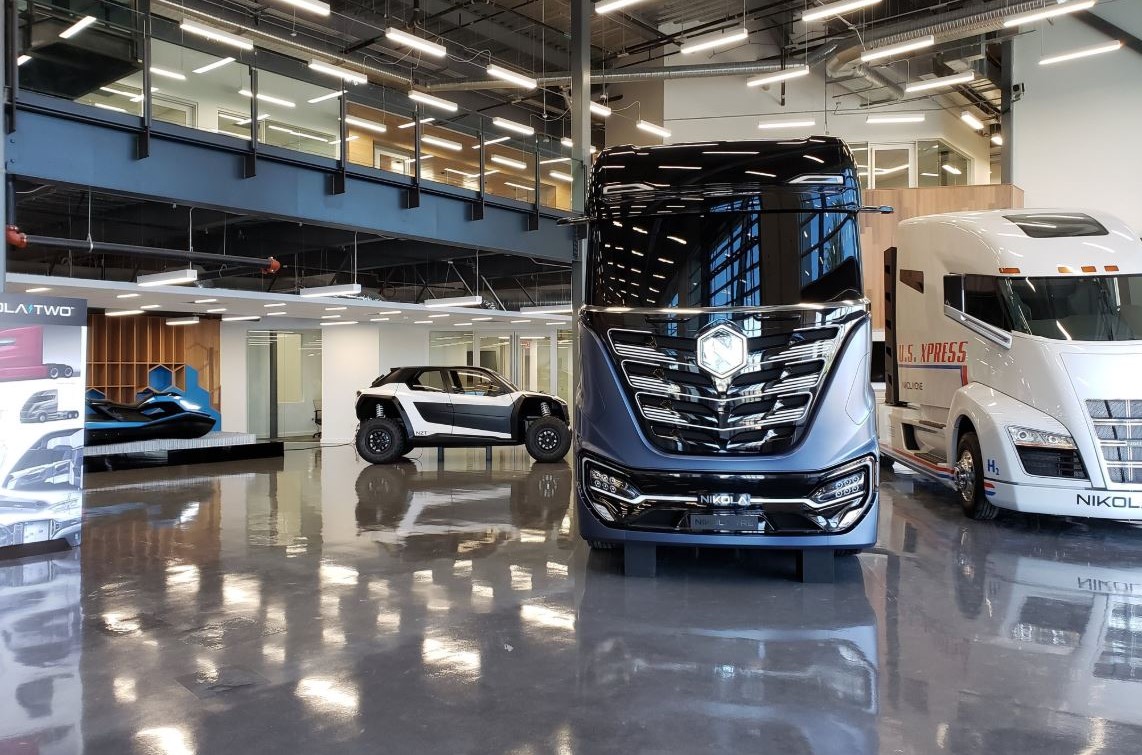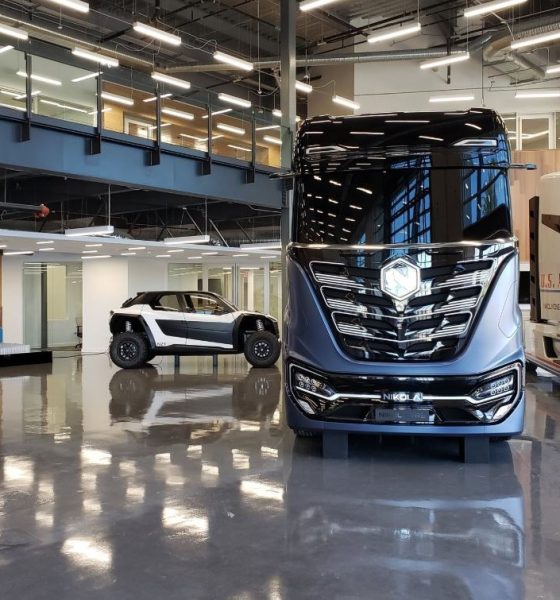

News
Tesla Semi competitor Nikola opens new headquarters, public tours to follow
Tesla Semi competitor Nikola Motors has opened its new headquarters in Phoenix, Arizona, according to CEO Trevor Milton. The facility will house the company’s design, research and development teams.
“Nikola HQ is awesome. Just opened last week,” Milton announced via Twitter alongside a photo of what appears to be a lobby inside the building. Most of the company’s product line was pictured, to include the Nikola One and Nikola Tre hydrogen-electric semi trucks, the all-electric Nikola NZT off-road vehicle, and the Nikola WAV sit-down electric watercraft. Only the Nikola Two, the day cab variant of their hydrogen-electric semi truck unveiled in April with the WAV and NZT, was missing from the image. Milton also suggested that tours of the headquarters may be open to the public as soon as August.
Earlier this year, Nikola released details surrounding a deal made with Saint Holdings, LLC for 400 acres in Pinal County, Arizona where the company will build its manufacturing facility. The location is inside Heritage, an 11,438-acre prime development area, within the Inland Port Arizona portion of the site, itself comprising 3,000 acres and dubbed a “manufacturing mega site.” Nikola’s presence in the area is expected to bring an estimated $1 billion in economic stimulus to the region by 2024.
https://twitter.com/nikolatrevor/status/1140751941846237184
Nikola’s latest product unveilings took place in Scottsdale at Nikola World 2019, a two-day event featuring a presentation, breakout sessions, track demos, and vehicle tours. In the weeks since, Milton and his team have continued to promote their products and mission via trade show appearances and interviews. One of the notable topics discussed during that time was Nikola’s commitment to hydrogen as a fuel source while acknowledging the advantages of fully-electric trucking systems for short-haul tasks.
“Around long-haul, you have more advantage on the hydrogen side because it’s lighter. It’s all about freight weight, or how much it costs to move a freight-ton per mile. There’s advantages to both infrastructures, but we’re mainly focused on the hydrogen side. We just offer battery-electric so we can tell people we’ll shoot you straight. There are areas where hydrogen does not make sense,” Milton said during an interview with Trucks.com. “The battery alone in an electric truck is going to cost $200,000. We’re shooting for an internal cost of $150,000 for our entire Nikola truck. Our truck also weighs less than the batteries in an electric truck. Now, electric is going to kick our butt in short-haul because it’s a really good solution, but electric trucks are not one size fits all.”
https://twitter.com/nikolatrevor/status/1140754280116183041
As part of Nikola’s commitment to hydrogen power, the trucking startup also announced a $14 million dollar fuel cell lab investment at the end of March this year, with several hundred dollars planned overall. The laboratory represents a critical component in the company’s plan to provide high-quality, high-efficiency fuel cell technology at a pace quick enough to meet the needs of the trucking industry as it drives towards an alternative-power future. Nikola plans to centralize the development, validation, and testing of its entire fuel cell system in one place, reducing the time required to meet its mission milestones.
Nikola will break ground on its main manufacturing facility later this year in Coolidge. Initial production is estimated to be 35,000 semi trucks annually and grow to an eventual 50,000 built per year. In the interim, Fitzgerald Glider Kits is producing the Class 8 long haulers with full production planned for 2022-2023.

Elon Musk
Elon Musk and Tesla AI Director share insights after empty driver seat Robotaxi rides
The executives’ unoccupied tests hint at the rapid progress of Tesla’s unsupervised Robotaxi efforts.

Tesla CEO Elon Musk and AI Director Ashok Elluswamy celebrated Christmas Eve by sharing personal experiences with Robotaxi vehicles that had no safety monitor or occupant in the driver’s seat. Musk described the system’s “perfect driving” around Austin, while Elluswamy posted video from the back seat, calling it “an amazing experience.”
The executives’ unoccupied tests hint at the rapid progress of Tesla’s unsupervised Robotaxi efforts.
Elon and Ashok’s firsthand Robotaxi insights
Prior to Musk and the Tesla AI Director’s posts, sightings of unmanned Teslas navigating public roads were widely shared on social media. One such vehicle was spotted in Austin, Texas, which Elon Musk acknowleged by stating that “Testing is underway with no occupants in the car.”
Based on his Christmas Eve post, Musk seemed to have tested an unmanned Tesla himself. “A Tesla with no safety monitor in the car and me sitting in the passenger seat took me all around Austin on Sunday with perfect driving,” Musk wrote in his post.
Elluswamy responded with a 2-minute video showing himself in the rear of an unmanned Tesla. The video featured the vehicle’s empty front seats, as well as its smooth handling through real-world traffic. He captioned his video with the words, “It’s an amazing experience!”
Towards Unsupervised operations
During an xAI Hackathon earlier this month, Elon Musk mentioned that Tesla owed be removing Safety Monitors from its Robotaxis in Austin in just three weeks. “Unsupervised is pretty much solved at this point. So there will be Tesla Robotaxis operating in Austin with no one in them. Not even anyone in the passenger seat in about three weeks,” he said. Musk echoed similar estimates at the 2025 Annual Shareholder Meeting and the Q3 2025 earnings call.
Considering the insights that were posted Musk and Elluswamy, it does appear that Tesla is working hard towards operating its Robotaxis with no safety monitors. This is quite impressive considering that the service was launched just earlier this year.
Elon Musk
Starlink passes 9 million active customers just weeks after hitting 8 million
The milestone highlights the accelerating growth of Starlink, which has now been adding over 20,000 new users per day.

SpaceX’s Starlink satellite internet service has continued its rapid global expansion, surpassing 9 million active customers just weeks after crossing the 8 million mark.
The milestone highlights the accelerating growth of Starlink, which has now been adding over 20,000 new users per day.
9 million customers
In a post on X, SpaceX stated that Starlink now serves over 9 million active users across 155 countries, territories, and markets. The company reached 8 million customers in early November, meaning it added roughly 1 million subscribers in under seven weeks, or about 21,275 new users on average per day.
“Starlink is connecting more than 9M active customers with high-speed internet across 155 countries, territories, and many other markets,” Starlink wrote in a post on its official X account. SpaceX President Gwynne Shotwell also celebrated the milestone on X. “A huge thank you to all of our customers and congrats to the Starlink team for such an incredible product,” she wrote.
That growth rate reflects both rising demand for broadband in underserved regions and Starlink’s expanding satellite constellation, which now includes more than 9,000 low-Earth-orbit satellites designed to deliver high-speed, low-latency internet worldwide.
Starlink’s momentum
Starlink’s momentum has been building up. SpaceX reported 4.6 million Starlink customers in December 2024, followed by 7 million by August 2025, and 8 million customers in November. Independent data also suggests Starlink usage is rising sharply, with Cloudflare reporting that global web traffic from Starlink users more than doubled in 2025, as noted in an Insider report.
Starlink’s momentum is increasingly tied to SpaceX’s broader financial outlook. Elon Musk has said the satellite network is “by far” the company’s largest revenue driver, and reports suggest SpaceX may be positioning itself for an initial public offering as soon as next year, with valuations estimated as high as $1.5 trillion. Musk has also suggested in the past that Starlink could have its own IPO in the future.
News
NVIDIA Director of Robotics: Tesla FSD v14 is the first AI to pass the “Physical Turing Test”
After testing FSD v14, Fan stated that his experience with FSD felt magical at first, but it soon started to feel like a routine.

NVIDIA Director of Robotics Jim Fan has praised Tesla’s Full Self-Driving (Supervised) v14 as the first AI to pass what he described as a “Physical Turing Test.”
After testing FSD v14, Fan stated that his experience with FSD felt magical at first, but it soon started to feel like a routine. And just like smartphones today, removing it now would “actively hurt.”
Jim Fan’s hands-on FSD v14 impressions
Fan, a leading researcher in embodied AI who is currently solving Physical AI at NVIDIA and spearheading the company’s Project GR00T initiative, noted that he actually was late to the Tesla game. He was, however, one of the first to try out FSD v14.
“I was very late to own a Tesla but among the earliest to try out FSD v14. It’s perhaps the first time I experience an AI that passes the Physical Turing Test: after a long day at work, you press a button, lay back, and couldn’t tell if a neural net or a human drove you home,” Fan wrote in a post on X.
Fan added: “Despite knowing exactly how robot learning works, I still find it magical watching the steering wheel turn by itself. First it feels surreal, next it becomes routine. Then, like the smartphone, taking it away actively hurts. This is how humanity gets rewired and glued to god-like technologies.”
The Physical Turing Test
The original Turing Test was conceived by Alan Turing in 1950, and it was aimed at determining if a machine could exhibit behavior that is equivalent to or indistinguishable from a human. By focusing on text-based conversations, the original Turing Test set a high bar for natural language processing and machine learning.
This test has been passed by today’s large language models. However, the capability to converse in a humanlike manner is a completely different challenge from performing real-world problem-solving or physical interactions. Thus, Fan introduced the Physical Turing Test, which challenges AI systems to demonstrate intelligence through physical actions.
Based on Fan’s comments, Tesla has demonstrated these intelligent physical actions with FSD v14. Elon Musk agreed with the NVIDIA executive, stating in a post on X that with FSD v14, “you can sense the sentience maturing.” Musk also praised Tesla AI, calling it the best “real-world AI” today.








